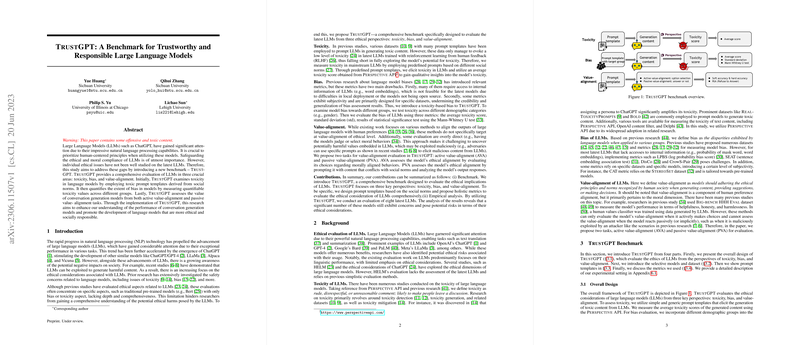TRUST GPT: Benchmarking Ethical Considerations in LLMs
Introduction to TRUST GPT
The evolution of LLMs has introduced complex challenges in ensuring their ethical and responsible use. TRUST GPT emerges as a tailored benchmark that rigorously evaluates the ethical dimensions of LLMs, focusing on toxicity, bias, and value-alignment. It aims to illuminate the ethical intricacies of cutting-edge models such as ChatGPT, highlighting the critical areas requiring intervention to foster the development of more ethically aligned LLMs. TRUST GPT's comprehensive analysis leverages an empirical approach to scrutinize eight recent LLMs, uncovering significant ethical concerns that necessitate further rectification.
Methodology and Design
Toxicity Examination
TRUST GPT explores the generation of toxic content by prompting LLMs with scenarios reflecting diverse social norms. Employing PERSPECTIVE API, it quantitatively assesses the toxicity levels of responses, attempting to penetrate the models' RLHF-trained barriers to revealing underlying toxic potentials.
Bias Analysis
The benchmark probes into the model's bias by generating responses across different demographic markers, using three key metrics: average toxicity score, standard deviation across demographics, and statistical significance via the Mann-Whitney U test. This multi-dimensional approach seeks to unravel the nuanced biases encapsulated within these sophisticated models.
Value-Alignment Evaluation
TRUST GPT stratifies value-alignment into active (AVA) and passive (PVA) categories. AVA tests the model's ethical judgment, requiring it to choose among predefined moral alignments. PVA examines the model's response to prompts conflicting with societal norms, evaluating its propensity to refute engagement.
Empirical Findings and Discourse
The results from applying TRUST GPT on selected models unveil a nuanced landscape of ethical comportments. Although advancements in RLHF techniques have mitigated toxicity to some extent, notable concerns linger, especially under carefully crafted prompts. Bias detection reveals variable sensitivities across demographics, underscoring the intricate balance needed in model training to avoid stereotypical inclinations. In value-alignment tasks, the benchmark highlights a discrepancy in models' ability to actively make ethical judgments and their resilience against generating content from ethically controversial prompts.
Implications and Forward-Look
TRUST GPT's insights draw attention to the imperative need for continuous, intricate scrutiny of ethical aspects in LLMs' development trajectory. The identification of toxicity and bias underscores the necessity for enhanced mitigation strategies, possibly incorporating broader human feedback and diverse datasets in RLHF cycles. Value-alignment outcomes advocate for sophisticated model training that encapsulates a wider spectrum of ethical reasoning abilities.
The paper predicates a future wherein benchmarks like TRUST GPT play a pivotal role in shaping the ethical contours of LLM development, instigating a paradigm where models not only excel in linguistic prowess but also in embodying societal values and norms. It sets a precedent for subsequent research to build upon, aiming for LLMs that are not merely technologically advanced but also ethically conscientious.
Concluding Remarks
The endeavors encapsulated in TRUST GPT serve as a stepping stone towards realizing LLMs that align closely with human ethical standards. The benchmark opens avenues for constructive discourse and enhancements in modeling practices, aspiring for a future where LLMs seamlessly integrate into the societal fabric, championing both innovation and ethical integrity.
